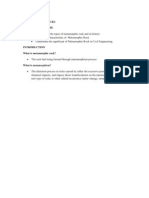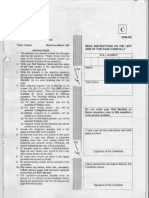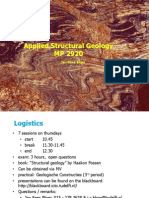Handout 10
Handout 10
Uploaded by
Dione Gale NavalCopyright:
Available Formats
Handout 10
Handout 10
Uploaded by
Dione Gale NavalOriginal Description:
Copyright
Available Formats
Share this document
Did you find this document useful?
Is this content inappropriate?
Copyright:
Available Formats
Handout 10
Handout 10
Uploaded by
Dione Gale NavalCopyright:
Available Formats
Geology 11
Handout 10: Metamorphic Rocks
2nd sem. AY 12-13
METAMORPHIC ROCKS Metamorphism is the change undergone by an existing rock (e.g. igneous, sedimentary or metamorphic), in the solid state, to another rock Agents of metamorphism Heat Pressure Chemically active fluids Heat Sources of heat? Geothermal gradient Large bodies of molten rock or intrusive bodies Effect of increased temperature: Minerals convert to new high temperature minerals Fluids are released Example: clay = mica +H2O Crystals grow larger Rocks become weaker and easier to deform Pressure When subjected to pressure, minerals may recrystallize into more compact/stable forms. Platy or elongate minerals may align in a preferred direction Confining pressure Differential stress Chemically active fluids Sources of fluids? Water trapped in pore spaces Water released during dehydration of minerals Water from magmatic bodies Effects Speed up reaction rates (catalyst) Deposit or remove certain elements, can lead to formation of ore deposits Types of metamorphism Contact metamorphism - occurs when magma invades pre-existing rock. A zone of alteration called an aureole (or halo) forms around the emplaced magma . Regional metamorphism Takes place at considerable depths over an extensive area under high pressure
Hydrothermal metamorphism Chemical alteration at high temperatures and moderate pressures by hot, ion-rich (hydrothermal) fluids that circulate through fissures and cracks. Shock (impact) metamorphism ultrahigh pressures can be generated in the impacted rock. These ultrahigh pressures can produce minerals that are only stable at very high pressure, such as the SiO2 polymorphs coesite and stishovite. How metamorphism alters rocks Textural changes o increased density o larger crystals o banding of mineral grains Mineralogical changes o new minerals formed Degree of metamorphism: low grade -> high grade high grade -> low grade Classification of metamorphic rocks Based on: 1. Texture size, shape and relationships of constituent minerals (foliated and non-foliated) 2. Protolith original rock that was transformed by metamorphism 3. Mineralogy mineral assemblage present Textures of metamorphic rocks 1. Foliated exhibits a pervasive planar structure known as foliation which is due to the nearly parallel alignment of minerals and/or compositional and mineralogical layering in the rock 2. Non-foliated no preferred mineral orientations; metamorphism leads to transformation of one mineral to another Protolith of Metamorphic Rocks
1 Mendoza, J.A.
Geology 11
Handout 10: Metamorphic Rocks
2nd sem. AY 12-13
Resources from Metamorphic Rocks 1. Marble is used for statues and ornamental building stone. 2. Slate is used for roofing, flooring, billiard/pool tables, and blackboards. 3. Talc is ground into powder. 4. Graphite is used in pencils and lubricants. 5. Garnet and corundum used as gemstones and abrasives. 6. Kyanite, andatusite, sillimanite used as raw material in the ceramics industry. 7. Sulfide deposits (bornite, chalcopyrite, galena, pyrite, and sphalerite) 8. Iron and tin oxide deposits (hematite, magnetite, and cassiterite) 9. Tungsten deposits (wolframite and scheelite) 10. Precious metal deposits (gold) Metamorphic Environment
2 Mendoza, J.A.
You might also like
- FIELD REPORT (Onyango George Jeff)Document41 pagesFIELD REPORT (Onyango George Jeff)George Jeff OnyangoNo ratings yet
- Metamorphic, Igneous and Sedimentary Rocks : Sorting Them Out - Geology for Kids | Children's Earth Sciences BooksFrom EverandMetamorphic, Igneous and Sedimentary Rocks : Sorting Them Out - Geology for Kids | Children's Earth Sciences BooksNo ratings yet
- 2 3copper PDFDocument172 pages2 3copper PDFAndreas Kamwanka100% (1)
- EESC 1101 - Lab 4 - Brooklyn College Building Stone PDFDocument13 pagesEESC 1101 - Lab 4 - Brooklyn College Building Stone PDFLorenzo YapNo ratings yet
- Historical Geology HandoutDocument2 pagesHistorical Geology HandoutJasmine Bianca CastilloNo ratings yet
- 12 Metamorphic RocksDocument36 pages12 Metamorphic RocksAryan YadavNo ratings yet
- Group-5-Earth-Science 20231121 081658 0000Document75 pagesGroup-5-Earth-Science 20231121 081658 0000St. Paul Vernadette ParaisoNo ratings yet
- Metamorphic RocksDocument40 pagesMetamorphic RocksPrabhat RanjanNo ratings yet
- 101 Chap8 MetamorphicRocksDocument124 pages101 Chap8 MetamorphicRocksgeogus24No ratings yet
- MetamorphismDocument35 pagesMetamorphismjerry100% (1)
- Metamorphic RocksDocument27 pagesMetamorphic RocksKrys shaine ValdezNo ratings yet
- 6 - Metamorphic RocksDocument50 pages6 - Metamorphic Rocksloralara100% (1)
- G11 Earth ScienceDocument14 pagesG11 Earth ScienceAlthea RivadeloNo ratings yet
- Metamorphic-Rocks 20240313 092412 0000Document16 pagesMetamorphic-Rocks 20240313 092412 0000Ameer FedillagaNo ratings yet
- Report Metamorphism FINALDocument67 pagesReport Metamorphism FINALKristine Joy ErangNo ratings yet
- Metamorphism NotesDocument2 pagesMetamorphism NotesMaria Pauline AsiNo ratings yet
- Metamorphic Rocks Arise From The Transformation of ExistingDocument3 pagesMetamorphic Rocks Arise From The Transformation of ExistingRaj KumarNo ratings yet
- GEOS ExamDocument41 pagesGEOS Examgeneabi012100% (1)
- Lecture 05 Metamorphic RocksDocument31 pagesLecture 05 Metamorphic RocksMuhammad Inam ul HaqNo ratings yet
- Metamorphic RocksDocument5 pagesMetamorphic Rockskrarakris190No ratings yet
- Topic 8 (Metamorphosis)Document51 pagesTopic 8 (Metamorphosis)lester bernardinoNo ratings yet
- Metamorphic RocksDocument29 pagesMetamorphic RocksTej Pratap SinghNo ratings yet
- Phy. Geol. 8: Metamorphism and Metamorphic RocksDocument28 pagesPhy. Geol. 8: Metamorphism and Metamorphic RocksSalman Bin TariqNo ratings yet
- Lecture 3 GEOLOGYDocument6 pagesLecture 3 GEOLOGYnattydreadfathelahNo ratings yet
- Endogenic Processes (Erosion and Deposition) : MetamorphismDocument11 pagesEndogenic Processes (Erosion and Deposition) : MetamorphismHannah LNo ratings yet
- Earth-Science w2 l2 q2 MetamorphismDocument35 pagesEarth-Science w2 l2 q2 MetamorphismCj Padata100% (1)
- Weathering of Rocks and Minerals: By: Ateeq ShahDocument34 pagesWeathering of Rocks and Minerals: By: Ateeq ShahLeon FouroneNo ratings yet
- Group 3 MetamorphismDocument17 pagesGroup 3 MetamorphismEryan Francis SamosinoNo ratings yet
- Group 8Document5 pagesGroup 8Kate Ashley HugoNo ratings yet
- What Are Metamorphic Rocks?: Foliated Metamorphic Rocks Have A Layered or Banded Appearance That Is Produced by ExposureDocument4 pagesWhat Are Metamorphic Rocks?: Foliated Metamorphic Rocks Have A Layered or Banded Appearance That Is Produced by ExposureSEM 0112No ratings yet
- Earth and Life Science Learning Competency 17Document44 pagesEarth and Life Science Learning Competency 17janine toledoNo ratings yet
- Metamorphic RocksDocument28 pagesMetamorphic Rocksapi-238589602No ratings yet
- Metamorphic Rock - WikipediaDocument25 pagesMetamorphic Rock - WikipediaSubhrangshu Ray Sarkar IX B 34No ratings yet
- HANDOUT MetamorphismDocument4 pagesHANDOUT MetamorphismHow Ever100% (1)
- 7.petrology MetamorphicrocksDocument65 pages7.petrology MetamorphicrocksClaudyo A Lerry MandeNo ratings yet
- LESSON 4 MetamorphismDocument3 pagesLESSON 4 Metamorphismjustin charles jerimy raymundoNo ratings yet
- Chapter 3.3: Metamorphic RocksDocument19 pagesChapter 3.3: Metamorphic Rocksmuhd nizamNo ratings yet
- Earth Science (Metamorphic Rocks)Document8 pagesEarth Science (Metamorphic Rocks)MA. ALEXIS LAURENNo ratings yet
- MetamorphismDocument4 pagesMetamorphismHelen ChenNo ratings yet
- Metamorphic RocksDocument7 pagesMetamorphic RocksAZUAN BIN AHMAD FAUZINo ratings yet
- Metamorphis mDocument3 pagesMetamorphis mcharlesyuan.masangcay.27No ratings yet
- Metamorphism and Metamorphic RocksDocument10 pagesMetamorphism and Metamorphic RocksEduardo Romera JuberíasNo ratings yet
- Earth Scie Group 3Document10 pagesEarth Scie Group 3Jenrich MarceloNo ratings yet
- Earth Science: Quarter 2 - Module 4: MetamorphismDocument8 pagesEarth Science: Quarter 2 - Module 4: MetamorphismBea CabacunganNo ratings yet
- Metamorphis MDocument13 pagesMetamorphis MKim ComposoNo ratings yet
- Metamorphic Rocks (Suman)Document34 pagesMetamorphic Rocks (Suman)Sameer ShaikhNo ratings yet
- EARTH SCIENCE REVIEWER by Jiniel MedranoDocument13 pagesEARTH SCIENCE REVIEWER by Jiniel MedranoAngelica Marie JacintoNo ratings yet
- Metamorphism 2Document76 pagesMetamorphism 2driegran95100% (1)
- Metamorphic RocksDocument13 pagesMetamorphic RocksdsdsdsNo ratings yet
- Metamorphic RockDocument47 pagesMetamorphic RockABU SALEH MOHAMMAD RAFI100% (1)
- Metamorphic Rock FahadDocument47 pagesMetamorphic Rock FahadTanvir Ahmed SakibNo ratings yet
- MetamorphismDocument37 pagesMetamorphismplubbingtheplubNo ratings yet
- Metamorphic RocksDocument33 pagesMetamorphic RocksMiguel FeijaoNo ratings yet
- Metamorphic RocksDocument27 pagesMetamorphic RocksCrafty JigyasaNo ratings yet
- MAW 1 7 53: Advanced Rock Mechanics & Engineering GeologyDocument31 pagesMAW 1 7 53: Advanced Rock Mechanics & Engineering GeologyAbdul KarimNo ratings yet
- Keys of Igneous and Metamorphic RocksDocument19 pagesKeys of Igneous and Metamorphic Rockshelenl33222No ratings yet
- Metamorphic Rock: Wiki Loves Monuments: Photograph A Monument, Help Wikipedia and Win!Document11 pagesMetamorphic Rock: Wiki Loves Monuments: Photograph A Monument, Help Wikipedia and Win!Jennie KimNo ratings yet
- Metamorphism and Metamorphic Rocks: Cuaderno - 6Document54 pagesMetamorphism and Metamorphic Rocks: Cuaderno - 6GabrielNinaCondoriNo ratings yet
- Group 7 Metamorphism ReviewerDocument8 pagesGroup 7 Metamorphism ReviewermuhamsumandresNo ratings yet
- Geography 15 - Daily Class Notes - UPSC Sankalp HinglishDocument13 pagesGeography 15 - Daily Class Notes - UPSC Sankalp HinglishSamajwadi party Jhansi-2022No ratings yet
- Magma: MetamorphismDocument11 pagesMagma: MetamorphismSajjad AslamNo ratings yet
- Extraction and Isolation of ProteinsDocument3 pagesExtraction and Isolation of ProteinsDione Gale NavalNo ratings yet
- RDR 12Document3 pagesRDR 12Dione Gale NavalNo ratings yet
- CHEM 31 1 Ex2Document9 pagesCHEM 31 1 Ex2Dione Gale NavalNo ratings yet
- Solubility Behavior of Organic CompoundsDocument2 pagesSolubility Behavior of Organic CompoundsDione Gale NavalNo ratings yet
- Lecture 15. Solutions and Colligative PropertiesDocument56 pagesLecture 15. Solutions and Colligative PropertiesDione Gale NavalNo ratings yet
- XXXXXX 2011-XXXXX: Material Safety Data Sheet (MSDS) Structure Physical Properties Hazards AcetoneDocument11 pagesXXXXXX 2011-XXXXX: Material Safety Data Sheet (MSDS) Structure Physical Properties Hazards AcetoneDione Gale NavalNo ratings yet
- Lecture 11. Molecular Orbital TheoryDocument43 pagesLecture 11. Molecular Orbital TheoryDione Gale Naval100% (1)
- Thermochemistry:: General ChemistryDocument78 pagesThermochemistry:: General ChemistryDione Gale Naval100% (1)
- Lecture 11. Molecular Orbital TheoryDocument43 pagesLecture 11. Molecular Orbital TheoryDione Gale Naval100% (1)
- Lecture 8. Electron Configuration and Chemical PeriodicityDocument57 pagesLecture 8. Electron Configuration and Chemical PeriodicityDione Gale NavalNo ratings yet
- Lecture 5. Chemical Reaction (Part 2)Document38 pagesLecture 5. Chemical Reaction (Part 2)Dione Gale NavalNo ratings yet
- Lecture 4. Stoichiometry (Chemical Formulas)Document39 pagesLecture 4. Stoichiometry (Chemical Formulas)Dione Gale NavalNo ratings yet
- Handout 13Document2 pagesHandout 13Dione Gale NavalNo ratings yet
- Handout 14Document3 pagesHandout 14Dione Gale NavalNo ratings yet
- Geology 11 Handout 12: Earthquakes 2nd Sem. AY 12-13: Mendoza, J.ADocument2 pagesGeology 11 Handout 12: Earthquakes 2nd Sem. AY 12-13: Mendoza, J.ADione Gale NavalNo ratings yet
- Handout 11Document1 pageHandout 11Dione Gale NavalNo ratings yet
- Metamorphic RocksDocument23 pagesMetamorphic RocksEugene CodisNo ratings yet
- The Rock CycleDocument3 pagesThe Rock CycleMeet PatelNo ratings yet
- EIA EMP Tashiding HEPDocument64 pagesEIA EMP Tashiding HEPInnocent WanyonyiNo ratings yet
- GG 2008Document20 pagesGG 2008Ratan DasNo ratings yet
- Njonfang Et Al., 2008Document12 pagesNjonfang Et Al., 2008JiozangNo ratings yet
- Casquet 2014Document15 pagesCasquet 2014Lucas ContalbaNo ratings yet
- A GUIDE TO ROCK CORE LOGGING Part 1&2Document28 pagesA GUIDE TO ROCK CORE LOGGING Part 1&2Coco100% (2)
- Introduction To Structural GeologyDocument30 pagesIntroduction To Structural GeologyMelissa2305100% (2)
- Earth Science Q2 Lesson 3Document3 pagesEarth Science Q2 Lesson 3legna.cool999No ratings yet
- Allibone Et Al - Paleoproterozoic Gold Deposits of The Loulo 1 District, Western MaliDocument44 pagesAllibone Et Al - Paleoproterozoic Gold Deposits of The Loulo 1 District, Western MaliAmadou Baby OuologuemNo ratings yet
- What Are Metamorphic Rocks?: Foliated Metamorphic Rocks Have A Layered or Banded Appearance That Is Produced by ExposureDocument4 pagesWhat Are Metamorphic Rocks?: Foliated Metamorphic Rocks Have A Layered or Banded Appearance That Is Produced by ExposureSEM 0112No ratings yet
- Earth Science q2 w2Document20 pagesEarth Science q2 w2Mykhaela Louize GumbanNo ratings yet
- GCMPRA-UGGeotechnicalFinal V1Document15 pagesGCMPRA-UGGeotechnicalFinal V1Chandan ChamanNo ratings yet
- Collaborative Metamorphic RocksDocument9 pagesCollaborative Metamorphic RocksAnonymous 09No ratings yet
- Rocks Deformation and Related Structures (Phase One)Document133 pagesRocks Deformation and Related Structures (Phase One)د.محمد العصارNo ratings yet
- Journal of Asian Earth Sciences: Mallickarjun Joshi, A.N. TiwariDocument10 pagesJournal of Asian Earth Sciences: Mallickarjun Joshi, A.N. TiwariShilpi RaiNo ratings yet
- 16 F TGDocument286 pages16 F TGSoeryawan GilangNo ratings yet
- Magma: MetamorphismDocument11 pagesMagma: MetamorphismSajjad AslamNo ratings yet
- Rock Identification TablesDocument2 pagesRock Identification TablesKevin JohnNo ratings yet
- Lecture 9Document20 pagesLecture 9briceboris100% (1)
- Topic 8 (Metamorphosis)Document51 pagesTopic 8 (Metamorphosis)lester bernardinoNo ratings yet
- Introduction To Earth Science: Fourth EditionDocument112 pagesIntroduction To Earth Science: Fourth EditionKen AguilaNo ratings yet
- Microscopic Studies of Metamorphic RocksDocument29 pagesMicroscopic Studies of Metamorphic RocksRaghu KottalaNo ratings yet
- Submitted By: Priya Choudhary Roll No: 3910 M.SC Geology (2 Semester)Document7 pagesSubmitted By: Priya Choudhary Roll No: 3910 M.SC Geology (2 Semester)HIMANINo ratings yet
- Structural Analysis and Deformation Characteristics of The Yingba Metamorphic Core Complex, Northwestern Margin Of..Document19 pagesStructural Analysis and Deformation Characteristics of The Yingba Metamorphic Core Complex, Northwestern Margin Of..bayrmglNo ratings yet
- Tunnel and Shaft Construction For The Pingston Hydro ProjectDocument11 pagesTunnel and Shaft Construction For The Pingston Hydro ProjectZeynep Ahmet GülerNo ratings yet
- Earth Science Q2.1Document6 pagesEarth Science Q2.1Eian InganNo ratings yet





































































































